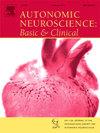The effects of rhythmic handgrip exercise on muscle sympathetic nerve activity: A systematic review and meta-analysis
IF 3.3
4区 医学
Q2 NEUROSCIENCES
引用次数: 0
Abstract
This systematic review and meta-analysis was conducted to quantify the sympathetic response to rhythmic handgrip exercise in healthy and diseased populations. Structured searches of databases were performed until June 12, 2024. We included all primary studies (other than systematic reviews and meta-analyses), and inclusion criteria were: population (all populations); intervention (rhythmic handgrip); comparator (baseline); and outcome (MSNA, BP, HR). Forty-nine studies (n = 930) were included. Burst frequency was elevated by 6.1 bursts/min during rhythmic handgrip (95 % CI, 4.52, 7.63; I2 = 53 %; p < 0.00001) across all populations. Similarly, burst incidence and total activity showed significant increases during handgrip (BI: MD, 3.0 bursts/100 hbs; 95 % CI, 0.11, 5.85; I2 = 0 %; p = 0.04; TA: MD, 49.4 a.u.; 95 % CI, 36.56, 62.20; I2 = 86 %; p < 0.00001). Subgroup analyses found greater responses in MSNA during rhythmic handgrip in healthy individuals compared to cardiovascular diseases and other conditions. Specifically, the change in burst frequency during handgrip (p = 0.0009) and total activity during handgrip (p < 0.00001) suggest a blunted sympathetic response to rhythmic handgrip in diseased populations. Meta-regression analyses in healthy populations found no relationship between the volume of handgrip applied with the associated change in sympathetic activity; however, there was a significant positive relationship between both the change in heart rate (slope = 0.131; adjusted R2 = 0.2773; p = 0.002) and the change in mean blood pressure (slope = 0.163; adjusted R2 = 0.3594; p < 0.001) with handgrip volume. An increase in MSNA is observed during rhythmic handgrip despite ranging protocols, populations, and co-interventions. These results suggest exercise is a unique stressor and challenges the understanding of general sympathetic hyperactivity in diseased populations.
有节奏的握力运动对肌肉交感神经活动的影响:系统回顾和荟萃分析
本系统综述和荟萃分析旨在量化健康和患病人群对有节奏握力运动的交感神经反应。数据库的结构化搜索一直持续到2024年6月12日。我们纳入了所有的初步研究(除了系统评价和荟萃分析),纳入标准为:人群(所有人群);干预(有节奏的握法);比较器(基线);结果(MSNA、BP、HR)。纳入49项研究(n = 930)。节律握力时爆发频率增加6.1次/min (95% CI, 4.52, 7.63;i2 = 53%;p & lt;0.00001)。同样,握力时爆发发生率和总活动显著增加(BI: MD, 3.0次爆发/100 hbs;95% ci, 0.11, 5.85;i2 = 0%;p = 0.04;TA:医学博士,49.4 a.u.;95% ci, 36.56, 62.20;i2 = 86%;p & lt;0.00001)。亚组分析发现,与心血管疾病和其他疾病相比,健康个体在节律性握力过程中MSNA的反应更大。具体来说,握拳期间突发频率的变化(p = 0.0009)和握拳期间总活动(p <;0.00001)表明在患病人群中对有节奏的握力的交感神经反应迟钝。健康人群的meta回归分析发现,握力的量与交感神经活动的相关变化之间没有关系;然而,两者之间存在显著的正相关关系(斜率= 0.131;调整后R2 = 0.2773;P = 0.002)和平均血压变化(斜率= 0.163;调整后R2 = 0.3594;p & lt;0.001)与握把量有关。尽管有不同的方案、人群和联合干预,但在有节奏的握拍过程中观察到MSNA的增加。这些结果表明,运动是一种独特的压力源,挑战了对患病人群普遍交感神经过度活跃的理解。
本文章由计算机程序翻译,如有差异,请以英文原文为准。
求助全文
约1分钟内获得全文
求助全文
来源期刊
CiteScore
5.80
自引率
7.40%
发文量
83
审稿时长
66 days
期刊介绍:
This is an international journal with broad coverage of all aspects of the autonomic nervous system in man and animals. The main areas of interest include the innervation of blood vessels and viscera, autonomic ganglia, efferent and afferent autonomic pathways, and autonomic nuclei and pathways in the central nervous system.
The Editors will consider papers that deal with any aspect of the autonomic nervous system, including structure, physiology, pharmacology, biochemistry, development, evolution, ageing, behavioural aspects, integrative role and influence on emotional and physical states of the body. Interdisciplinary studies will be encouraged. Studies dealing with human pathology will be also welcome.

 求助内容:
求助内容: 应助结果提醒方式:
应助结果提醒方式:


